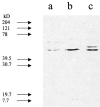Gi-Protein alpha-subunit mRNA antisense oligonucleotide inhibition of Gi-coupled receptor contractile activity in the epididymis of the guinea-pig
- PMID: 10369459
- PMCID: PMC1565995
- DOI: 10.1038/sj.bjp.0702515
Gi-Protein alpha-subunit mRNA antisense oligonucleotide inhibition of Gi-coupled receptor contractile activity in the epididymis of the guinea-pig
Abstract
We have used a reversible permeabilization method to facilitate the entry of Gialpha1, 2 and 3 G-protein subunit mRNA antisense or mismatch oligonucleotides into intact tissue, to investigate the G-protein alpha-subunit coupling of alpha2-adrenoceptors, neuropeptide Y (NPY) Y1, and A1 adenosine receptors in preparations of the epididymis of the guinea-pig. The alpha2-adrenoceptor agonist, xylazine, elicited concentration dependent contractions from preparations of phenylephrine (3 microM)-stimulated epididymis (pEC50 value 6.52+/-0.39, maximum response 236+/-41 mg force). Compared to respective mismatch controls the incubation of preparations with Gialpha2, but not with Gialpha1 or Gialpha3 mRNA antisense oligonucleotides (30 microM) reduced the maximal xylazine-potentiation of phenylephrine (3 microM)-stimulated contractility (to 51+/-12% of Gialpha2 mismatch control). The oligonucleotide incubations had no effect upon the pEC50 values of xylazine. The A1 adenosine receptor agonist, cyclopentyladenosine (CPA) elicited concentration dependent contractions from preparations of phenylephrine (3 microM)-stimulated epididymis (pEC50 value 7.66+/-0.57, maximum response 208+/-54 mg force). Incubation of preparations of epididymis with Gialpha1, but neither Gialpha2 nor Gialpha3 antisense oligonucleotides reduced the maximal CPA-potentiation of phenylephrine (3 microM)-stimulated contractions (to 55+/-17% of Gialpha1 mismatch control), pEC50 values were not affected. The incubation of preparations with Gialpha2 antisense mRNA oligonucleotides reduced the maximal NPY-potentiation of phenylephrine (3 microM)-stimulated contractions (to 62+/-15% of Gialpha mismatch control). Compared with Gialpha2 mismatch controls, the incubation of preparations with Gialpha1 and Gialpha3 oligonucleotides also reduced the NPY-potentiation of phenylephrine (3 microM)-stimulated contractions. These studies indicate that, in the guinea-pig epididymis, alpha2-adrenoceptors and A1 adenosine receptors preferentially couple to effectors through Gialpha2 and Gialpha1 subunits respectively. In contrast NPY receptors may elicit effects through either Gialpha1, 2 or 3 subunits.
Figures






References
-
- AKHTAR S., AGRAWAL S. In vivo studies with antisense oligonucleotides. Trends Pharmacol. Sci. 1997;18:12–18. - PubMed
-
- BITAR K.N., ZHU X.X. Expression of bombesin-receptor subtypes and their differential regulation of colonic smooth muscle contraction. Gastroenterol. 1993;105:1672–1680. - PubMed
-
- BRADFORD M.M. A rapid and sensitive method for the quantitation of microgram quantities of protein utilizing the principle of protein-dye binding. Analytic Biochem. 1976;72:248–254. - PubMed
-
- CLAPHAM D.E. The G-Protein nanomachine. Nature. 1996;379:297–299. - PubMed
Publication types
MeSH terms
Substances
LinkOut - more resources
Full Text Sources
Research Materials
Miscellaneous

